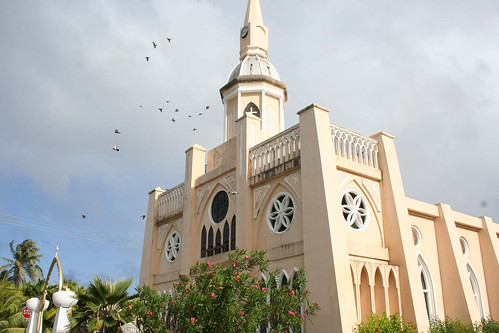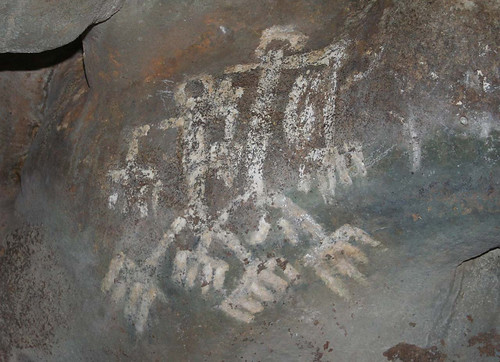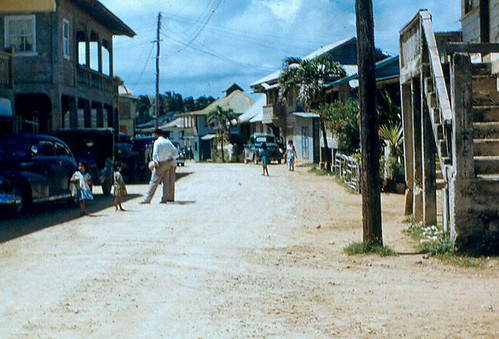View more photos for the Inalåhan (Inarajan) entry here.
Origin of village name in CHamoru
The village’s CHamoru name, Inalåhan, probably refers to the åla or large woven coconut-leaf harvest baskets for which the village was noted. The name could also be derived from the word hålla, meaning to pull something or move something with a rope tied to it. In written historical documents, the Spanish changed all the l’s in CHamoru words to r’s, thus changing the village’s name to Inarajan. The official spelling was changed in 2021 to Inalåhan.
Population
As of the 2010 US Census, the population was 2,273.
Village officials
The current mayor is Anthony P. Chargualaf.
Village description
To the outside eye, the village of Inalåhan seems to have been untouched by the hand of change. It is known as the most distinctly Spanish-style village on the island, with the village proper on Inalåhan Bay, remaining basically intact over the decades.
A visitor could drive through the small Spanish barrio-style streets, which until recently were one-way streets, and see the history of Inalåhan in its old houses. The houses reflect a mixture of architecture influenced by the Spanish period and the early American period (early 1900s).
The village retains many of its traditional ways, with the St. Joseph Church still at the center of many activities, including the village’s annual fiestas. Residents of the village are still a small number of families whose roots are deeply entwined in Inalåhan. Very few outsiders have moved into the village, and very few modern structures have been erected.
Part of what gives Inalåhan its heritage-rich flavor is one of its more recent additions: the Gef Pa’go Cultural Village, which sits right on the bay. The village, which consists of ancient-style thatch-roofed huts, is staffed mainly by elder CHamorus who demonstrate traditional CHamoru arts, crafts, and cooking to visitors. A younger group of CHamoru cultural dancers also performs at Gef Pa’go called Inetnon Gef Pa’go.
Residents from all over the island drive south for Inalåhan’s famous Hotnu Bakery, at the Gef Pa’go Cultural Village. The bakery serves freshly-made bread and pizzas cooked in the historic place. The bakery is open 10 am to 3 pm Wednesdays, Saturdays, and Sundays as of 2019.
The village was listed in the National Register of Historic Places in 1977 as an historic district, and is also designated as a folk arts village receiving federal funds for the preservation of its arts and culture. But to the older CHamorus, or manåmko’, of the village, there are noticeable changes that have occurred in Inalåhan over the past few decades. The busloads of tourists and schoolchildren that come to visit Gef Pa’go, for example, have changed the pace of the village a bit. To accommodate those buses and other visitors, one of the one-way roads was expanded and paved into a modern two-lane road.
Inalåhan is divided into different sections, including areas known as Lada (near Bear Rock), Belen, Peca, Chagamin Lago, Se’se’ (going uphill to Inalåhan Middle School), and Tinaga. One of the biggest sections is Malojloj, which sits uphill and north of the main village. The subcommunity of Malojloj began as a farming community in the 1950s and has grown over the past twenty years, so that it now has its own Catholic church, San Isidro, as well as a gas station, a convent, a solid waste transfer station, and the Inalåhan mayor’s office.
Also north of the main village is the Inalåhan public health clinic, the University of Guam Agricultural Experiment Station, the Inalåhan Senior Citizens Center, Fire Station #16, Department of Public Works bus satellite station, US Post Office, and the wastewater treatment plant.
Driving south of the main village, the road passes natural swimming pools known as Salaglula Pools, and the small, seaside Tipogo Cemetery. The road nearly touches the ocean at Agfayan Bay, where visitors can see the famous Bear Rock, which at some angles is shaped like a bear. The newly constructed boat ramp near Agfayan Bridge is an ideal spot to take snapshots of Bear Rock. Further south is the Inalåhan Garden House (a resort reserved exclusively for employees of a Japanese corporation) and privately owned family beaches.
Village history
Not much is known about the early inhabitants of Inalåhan, which was a village before the Spanish arrived on Guam. The village was officially established in 1680 by the Spanish, along with St. Joseph Church, and was one of the main villages on Guam during the Spanish era. The village was designed in the Spanish custom with the church as its focus.
The Spanish were also responsible for an unusual addition to the residents of the village, as the residents of the northernmost Mariana Islands, known as Gåni (including Anatahan, Sarigan, Alamagan, Pagan, Agrihan, and Asuncion), were relocated to Inalåhan and Malesso’ in the late 1600s. The Spanish relocation of the CHamorus, including the consolidation of the villages of Guam, was done to better control the local people during the Spanish-CHamoru wars that were going on at the time. There is still a section of Inalåhan known as “As Gani” today.
The St. Joseph Church is named after the village’s patron saint of San Jose or St. Joseph. It contains a large statue of St. Joseph that, according to oral tradition, was brought to Guam by the Spanish, who intended to bring it to Humåtak. But a storm prevented the ship from going to Humåtak, and it ended up landing in Inalåhan, where the statue remained.
The church has been rebuilt several times, and the current church was built in 1939. It was damaged during the bombing of World War II, and in the earthquake of 1993, the church’s steeple fell to the ground. It was rehabilitated in the late 1990s by the Parish Council, the church Pastor, and parishioners.
The church is famous as being the burial site of Father Jesus Baza Duenas, a local martyr who was one of the only two CHamoru priests on Guam during World War II. Father Duenas was arrested on 8 July 1944 in Inalåhan by the Japanese police on suspicion of aiding the American fugitive, Navy radioman George Tweed. Father Duenas had also angered the Japanese authorities by opposing official directives and calling the two Japanese priests on Guam propagandists for Japan. He was tortured, along with his nephew, former Island Attorney Eduardo Duenas, at Inalåhan and at the police headquarters in Agana Heights. On July 12, the two men were beheaded at Tai, a section in the village of Mangilao. Father Duenas’s body was exhumed in March 1945 and reburied under the altar of St. Joseph’s, where he had served. The island’s only Catholic boys’ high school in Tai, Mangilao is named after him.
While Inalåhan, sitting so close to the sea, has been hit hard by a number of typhoons, the most notable include a supertyphoon in 1900 that killed twenty-eight Inalåhan residents when huge waves engulfed the village, and Typhoon Allyn, which destroyed many homes in the village in 1949.
Points of interest
Village map
Institutions
Inalåhan Elementary School
This school, built in 1997, is a Guam Department of Education elementary school. It is located south of the main village.
Inalåhan Middle School
Inalåhan Middle School, one of eight public middle schools, was constructed in 1973 and served as a high school until the late 1990s. It is now a small middle school that sits atop a hill above the village.
St. Joseph Church
Inalåhan’s Catholic church was established by the Spanish in late 1680 and has been rebuilt several times, most recently in the late 1990s. It has been the center of the village for several hundred years. The village holds two fiestas for its patron saint: one in March in honor of St. Joseph, Husband of Mary, and another in May in honor of St. Joseph, the Worker.
It is also the burial site of Father Jesus Baza Duenas, a martyr who was one of the two CHamoru priests on Guam during World War II.
San Isidro Church
Located in Malojloj, this Catholic church is a more recent structure than St. Joseph’s. However, Malojloj residents take equal pride in their celebration of the Malojloj fiesta in May every year in honor of their patron saint, San Isidro.
Historical
Baptist Church ruins
Colorful bouganvilla cover the last remaining wall of the church which was initially constructed in the early 1900s adjacent to the Gef Pa’go Cultural Village along Inalåhan Bay. Beside it is a statue of legendary Chief Gadao erected in the late 1980s.
Gadao’s Cave
Located in the area of Guaifan, near the entrance to Inalåhan Bay, is a cave with ancient pictographs of stick figure people well known on Guam and often used as cultural icons. Chief Gadao was a legendary chief of Inalåhan who, according to legend, outsmarted a chief from Tumon who came to Inalåhan to challenge Gadao to contests of strength. Part of the legend tells how the two powerful chiefs rowed a canoe in opposite directions, breaking the canoe in half. A statue of Chief Gadao rowing his half of the canoe back to Inalåhan is located along the shores of the main village.
Historic homes
Some of the oldest homes in the village have been preserved using federal funds, and the Gef Pa’go Cultural Village gives a tour of the Leon Guerrero House, built in 1901, which housed the village commissioner and his 16 children.
The Jose Duenas Cruz (Beck-Ping Cruz) House is still being maintained by the Historic Inalahan Foundation. The George Flores two-story building is under care of the Guam Preservation Trust, which has led restoration of much of historic Inalåhan.
Recreational
Bear Rock
Sitting at the edge of Agfayan Bay is a large, natural formation of rock that from some angles looks like the shape of a bear. Older residents know the rock as “Lasso’ Gi’ai,” which refers to male genitalia.
Gef Pa’go Cultural Village
Located along Inalåhan Bay in the main village, the thatched huts of Gef Pa’go are a popular attraction for students, tourists and other interested visitors who want to learn about the island’s past. Manåmko’ will tell visitors stories of their childhood and give them demonstrations of traditional CHamoru cooking, crafts and arts. The cultural center also has exhibits of ancient CHamoru tools, tours of historical homes in the village, and cultural dances.
Salaglula Pools
These natural pools of sea water are located toward the southern side of the main village.
Talo’fo’fo Bay Beach Park
This black-sand beach, which eroded considerably in the late 1990s, was once a popular park for swimmers and family gatherings. Though the pavilions are mostly destroyed now, the bay remains one of the island’s prime surfing spots. Although it is named Talo’fo’fo Bay park, its facilities are on the southern side of the bay, the area most people visit, is actually part of Inalåhan.
Village mayors/commissioners
Mayors/Commissioners
- Anthony P. Chargualaf, Mayor, 2020-Present
- Doris Flores Lujan, Mayor, 2013-2020
- Franklin M. Taitague, Mayor, 2001-2012
- Jesse LG Perez, Mayor, 1993-2001
- Juan C. Cruz, Commissioner/Mayor, 1989-1993
- Jaime DS Paulino, Commissioner, 1981-1989
- Alfred SN Flores, Commissioner, 1976-1981
- Jose P. San Nicolas, Commissioner, 1973-1976
- Joaquin SN Diego, Commissioner, 1944-1973
- Pedro M. Mantanona, Commissioner, 1935-1944
- Mariano R. Leon Guerrero, Commissioner, 1935
- Enrique Paulino Naputi, Commissioner, 1928
- Romaldo C. Diego, Commissioner, 1919
- Manuel D. Flores, Commissioner, 1917
- Mariano R. Leon Guerrero, Commissioner, 1910
- Jesus Aguon Flores, Commissioner, 1900
- (No information is available for the century between Jesus Aguon Flores and Juan Mesa Naputi)
- Juan Mesa Naputi, Commissioner, 1800
- Jose Evaristo Duenas, Commissioner, (no date provided)
- Jose Meno, Commissioner, (no date provided)
- Antonio (Julian) Mantanona, Commissioner, (no date provided)
Deputy Commissioners
- Enemesio SN Diego, Deputy Commissioner, 1935-1944
- Pedro M. Mantanona, Deputy Commissioner, 1928
- Ramon Guzman Fejeran, Deputy Commissioner, 1919
- Jose LG Fejeran, Deputy Commissioner, 1917
Editor’s note: The preceding list was provided by Konsehelon Mahot Guåhan/the Mayor’s Council of Guam.
For further reading
Guam Department of Parks and Recreation. “Guam State Historic Preservation Office.”
Herman, RDK. “Inarajan Indigenous Geography Home Page.” Pacific Worlds, 2003.
Mayors Council of Guam. “MCOG – Mayors Council of Guam.”
Onedera, Peter R., ed. Nå’an Lugåt Siha gi ya Guåhan (Guam Place Names). Hagåtña: Chamorro Language Commission, 1988.






